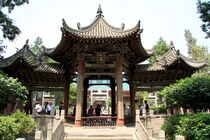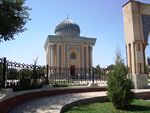كتاب الهان (الإسلامي)
| جزء من سلسلة عن الإسلام في الصين |
|---|
 |
|
|
كتاب الهان أو هان كتاب (الصينية المبسطة: 汉克塔布; الصينية التقليدية: 漢克塔布; پنين: Hàn kètǎbù؛ إنگليزية: Han Kitab) هو مجموعة من النصوص الإسلامية الصينية، كتبها مسلمون صينيون، تمزج الإسلام والكونفوشية. الاسم يعكس هذا المزيج: هان هي الكلمة الصينية التي تعني "صيني" و كتاب هي كلمة عربية.[1][2] وقد كـُتـِبوا في مطلع القرن 18 في عهد أسرة تشينگ من مؤلفين مسلمين صينيين. انتشر كتاب الهان على نطاق واسع وحاز قبول المسلمين الصينيين اللاحقين، أمثال ما چيشي، ما فوشيانگ، و هو سونگشان.[3][4]
التاريخ
The origins of Han Kitab literature can be traced back to the establishment of the scripture hall education (jingtang jiaoyu) system created by scholar Hu Dengzhou in the 16th century. After studying abroad in the Islamic world for years, Hu returned to China and formed the educational system, which incorporated the use of authoritative Islamic texts and foreign language lessons mixed with Chinese.[5] Initially the Han Kitab was composed of Chinese translations of Sufi texts originally written in Persian. Around the mid-17th century, Chinese Muslim scholars began writing original texts that synthesized Islamic and Classical Chinese thought.[6] Within a few generations, the instructional system spread throughout China, and subsequent scholars began writing Islamic literature within a Chinese cultural context.[5]
التأليف
قام ليو ژي بكتابة كتاب الهان في نانجينگ في مطلع القرن 18.[7] أعمال وو زونچيى، ژانگ ژونگ، و وانگ داييو كانت مُتضمَّنة في كتاب الهان.[8]
المراجع
- ^ Dillon (1999), p. 131.
- ^ Lipman (2004), p. 73.
- ^ Lipman (2004), pp. 176, 189–190, 221.
- ^ Wroldsen, Kim Jarle (2021). "Let Confucianism and Islam work together: bargaining for a distinct Muslim identity in local propaganda literature". Asian Ethnicity: 1–24. doi:10.1080/14631369.2021.2007754. ISSN 1463-1369. S2CID 244676304.
- ^ أ ب Petersen, Kristian (2021-07-27). "The Rich History of China's Islam". New Lines Magazine (in الإنجليزية). Retrieved 2022-03-19.
{{cite web}}: CS1 maint: url-status (link) - ^ Benite, Zvi Ben-Dor (2000-01-01), Follow the white camel: Islam in China to 1800, Cambridge University Press, pp. 409–426, doi:, ISBN 9781139056137, http://dx.doi.org/10.1017/chol9780521850315.013, retrieved on 2022-09-01
- ^ Lipman (2004), p. 226.
- ^ Lipman (2004), p. 79.
ببليوگرافيا
- Dillon, Michael (1999). China's Muslim Hui community: migration, settlement and sects. Richmond: Curzon Press. ISBN 0-7007-1026-4. Retrieved 2010-06-28.
- Lipman, Jonathan Neaman (2004). Familiar strangers: a history of Muslims in Northwest China. Seattle: University of Washington Press. ISBN 0-295-97644-6. Retrieved 2010-06-28.
قالب:Islam-book-stub قالب:China-lit-stub قالب:China-philo-stub
- CS1 maint: url-status
- Articles containing simplified Chinese-language text
- Articles containing traditional Chinese-language text
- Articles containing إنگليزية-language text
- Pages using Lang-xx templates
- Sunni literature
- Islamic literature
- Confucian texts
- Chinese philosophy
- Chinese classic texts
- Chinese literature
- 18th-century books
- الإسلام في الصين
- Religious syncretism
- Maturidi literature
